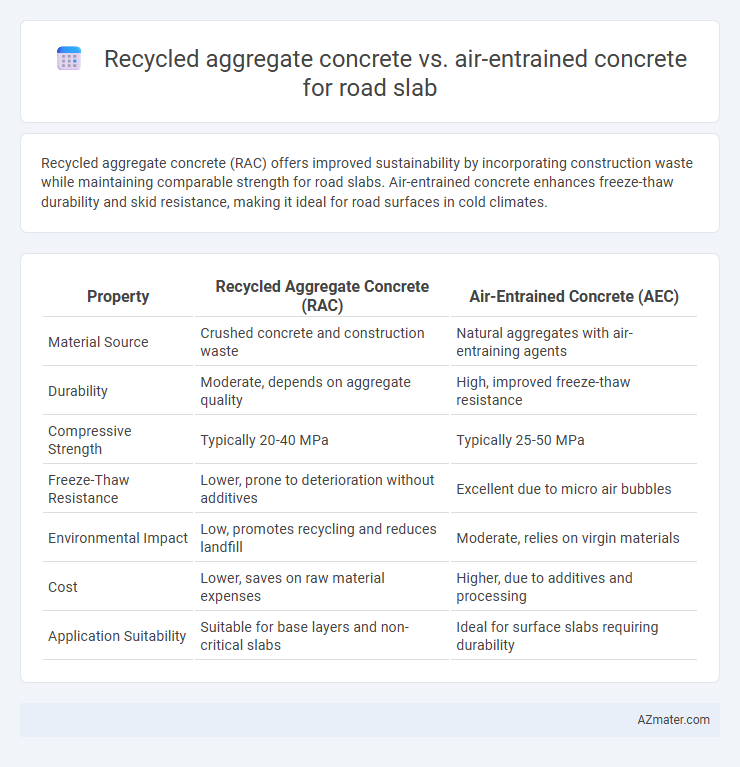Recycled aggregate concrete (RAC) offers improved sustainability by incorporating construction waste while maintaining comparable strength for road slabs. Air-entrained concrete enhances freeze-thaw durability and skid resistance, making it ideal for road surfaces in cold climates.
Table of Comparison
| Property | Recycled Aggregate Concrete (RAC) | Air-Entrained Concrete (AEC) |
|---|---|---|
| Material Source | Crushed concrete and construction waste | Natural aggregates with air-entraining agents |
| Durability | Moderate, depends on aggregate quality | High, improved freeze-thaw resistance |
| Compressive Strength | Typically 20-40 MPa | Typically 25-50 MPa |
| Freeze-Thaw Resistance | Lower, prone to deterioration without additives | Excellent due to micro air bubbles |
| Environmental Impact | Low, promotes recycling and reduces landfill | Moderate, relies on virgin materials |
| Cost | Lower, saves on raw material expenses | Higher, due to additives and processing |
| Application Suitability | Suitable for base layers and non-critical slabs | Ideal for surface slabs requiring durability |
Introduction to Sustainable Road Construction
Recycled aggregate concrete enhances sustainable road construction by incorporating crushed concrete debris, reducing natural resource depletion and landfill waste. Air-entrained concrete improves durability and resistance to freeze-thaw cycles, extending the lifespan of road slabs in cold climates. Combining recycled aggregates with air-entrainment technology optimizes environmental benefits while ensuring structural performance in modern pavement engineering.
Understanding Recycled Aggregate Concrete
Recycled aggregate concrete (RAC) incorporates crushed concrete debris as aggregate, offering sustainable alternatives in road slab construction by reducing natural resource consumption and landfill waste. Its mechanical properties, such as compressive strength and durability, depend significantly on the quality of recycled aggregates and mix design, often matching conventional concrete when properly processed. Compared to air-entrained concrete, which is designed primarily for enhanced freeze-thaw resistance through microscopic air bubbles, RAC requires focused attention on aggregate composition to ensure long-term performance in road slab applications.
Fundamentals of Air-Entrained Concrete
Air-entrained concrete incorporates microscopic air bubbles that improve freeze-thaw durability and resistance to scaling in road slabs exposed to harsh climates. This fundamental property enhances the concrete's ability to withstand cyclic freezing and thawing by providing space for water expansion, reducing internal stresses and cracking. While recycled aggregate concrete primarily focuses on sustainability and resource reuse, air-entrained concrete specifically targets enhanced durability and longevity in pavement applications.
Material Properties Comparison
Recycled aggregate concrete (RAC) incorporates crushed concrete and other recycled materials, offering moderate compressive strength and reduced environmental impact, but often shows higher water absorption and lower durability compared to air-entrained concrete. Air-entrained concrete (AEC) contains microscopic air bubbles that enhance freeze-thaw resistance and durability, making it more suitable for road slabs in cold climates. While RAC provides sustainability advantages, AEC typically exhibits superior frost resistance, improved workability, and enhanced long-term performance in road slab applications.
Durability and Longevity in Road Slabs
Recycled aggregate concrete (RAC) offers sustainable benefits but may exhibit reduced durability in road slabs due to higher porosity and weaker interfacial transition zones, potentially leading to increased water absorption and freeze-thaw damage compared to air-entrained concrete (AEC). Air-entrained concrete enhances durability by incorporating microscopic air bubbles that improve resistance to freeze-thaw cycles and reduce scaling, which is critical for road slab longevity in cold climates. Studies show AEC provides superior performance in maintaining structural integrity and reducing maintenance costs over the lifespan of road slabs under harsh environmental conditions.
Workability and Finishing Techniques
Recycled aggregate concrete (RAC) exhibits reduced workability compared to air-entrained concrete due to the higher absorption rate and irregular shape of recycled aggregates, requiring additional water or admixtures to achieve desired flow. Air-entrained concrete improves workability and finishing by incorporating microscopic air bubbles that enhance frost resistance and reduce surface scaling, making it easier to produce smooth, durable road slabs. Finishing techniques for RAC demand careful moisture control and vibration to ensure compaction, while air-entrained concrete benefits from conventional finishing tools and methods to optimize surface texture and longevity.
Resistance to Freeze-Thaw Cycles
Recycled aggregate concrete demonstrates moderate resistance to freeze-thaw cycles, but its durability can be enhanced with proper mix design and supplementary cementitious materials. Air-entrained concrete, specifically designed with microscopic air bubbles, provides superior freeze-thaw resistance by relieving internal stress caused by water expansion during freezing. For road slabs exposed to harsh winter conditions, air-entrained concrete typically offers better long-term durability and structural integrity.
Environmental Impact Assessment
Recycled aggregate concrete (RAC) significantly reduces environmental impact by minimizing natural aggregate depletion and lowering carbon emissions through material reuse, making it a sustainable choice for road slab construction. Air-entrained concrete improves durability and freeze-thaw resistance but relies on virgin materials with higher embodied energy, thus presenting a comparatively larger carbon footprint. Life Cycle Assessment (LCA) studies highlight RAC's advantage in reducing landfill waste and overall ecological disruption while maintaining structural performance in road slabs.
Cost Analysis and Economic Viability
Recycled aggregate concrete significantly reduces material costs by utilizing construction waste, offering up to 30% savings compared to conventional aggregates used in air-entrained concrete for road slabs. Air-entrained concrete, while more expensive due to admixture costs, provides enhanced freeze-thaw durability, potentially decreasing long-term maintenance expenses. Economic viability depends on project location, material availability, and climate conditions, with recycled aggregate concrete favored in regions prioritizing sustainability and cost-efficiency, whereas air-entrained concrete suits colder climates requiring superior frost resistance.
Recommendations for Road Slab Applications
Recycled aggregate concrete (RAC) is recommended for road slabs due to its sustainability and adequate compressive strength, although it requires careful quality control to manage potential porosity and durability issues. Air-entrained concrete enhances freeze-thaw resistance and durability, making it ideal for road slabs in cold climates where moisture damage is a concern. For optimal road slab performance, combining RAC with air-entrainment techniques can balance environmental benefits with improved durability and resistance to freeze-thaw cycles.

Infographic: Recycled aggregate concrete vs Air-entrained concrete for Road slab
 azmater.com
azmater.com